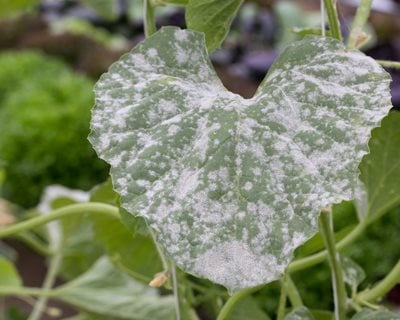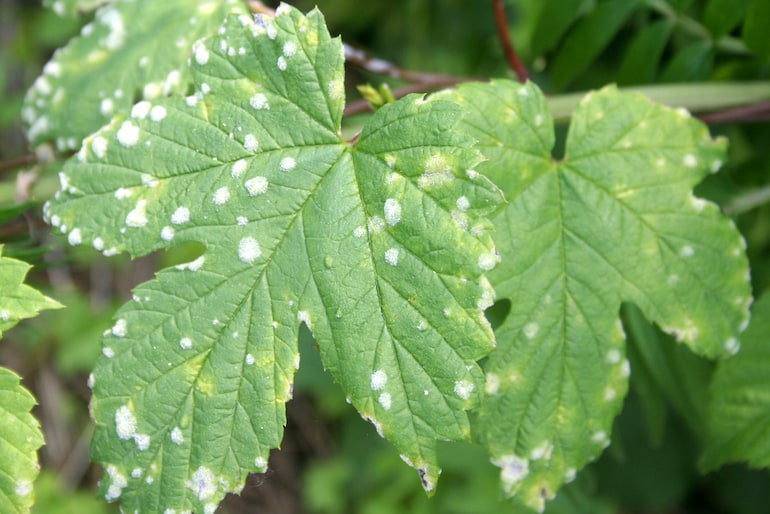
Powdery mildew is a common fungal disease that affects a wide range of plants, from vegetables to flowers. Its name comes from the white or grey powdery spots it forms on leaves and stems. This disease thrives in warm, dry conditions but can be found in various climates.
As a gardener, recognising powdery mildew early is crucial. The earlier you detect it, the easier it is to manage and prevent it from spreading. It doesn't just affect the appearance of your plants; it can also reduce their vigour and productivity.
Imagine seeing your plant leaves covered in a dusting of flour. That's what powdery mildew looks like. These powdery patches often start small but can quickly cover larger areas if left untreated. They typically appear on the upper surfaces of leaves but can also be found on stems, buds, and flowers.
Early detection is key. Look for small, circular, powdery spots that gradually expand. If you notice your plants looking a bit ghostly, it's time to take action.
Several factors contribute to the development of powdery mildew. High humidity and poor air circulation are among the most significant. When plants are crowded together, air can't move freely around them, creating a perfect environment for this fungus to thrive.
Susceptible plant species also play a role. Some plants are naturally more prone to powdery mildew than others. Knowing which plants are at risk can help you take preventive measures.
While powdery mildew rarely kills plants, it can significantly weaken them. The fungus interferes with photosynthesis, the process by which plants convert sunlight into energy. As a result, affected plants may grow more slowly, produce fewer flowers or fruits, and become more susceptible to other diseases and pests.
Severe infections can lead to yellowing leaves, premature leaf drop, and a general decline in plant health. Therefore, managing powdery mildew is not just about aesthetics; it's about maintaining healthy, thriving plants.

"Powdery Mildew Treatment & Prevention ..." from www.gardendesign.com and used with no modifications.
Understanding the conditions that favour powdery mildew can help you prevent its occurrence. This knowledge empowers you to create an environment where your plants can thrive without the constant threat of this pesky fungus.
Powdery mildew thrives in environments with high humidity and moderate temperatures. It often appears during late spring and early summer when these conditions are prevalent. However, it can also persist in greenhouse environments where humidity levels are consistently high.
Not all plants are equally susceptible to powdery mildew. For instance, cucumbers, squash, roses, and zinnias are known to be more vulnerable. On the other hand, certain varieties have been bred for resistance. When planning your garden, consider choosing these resistant varieties to minimize the risk.
Once powdery mildew takes hold, it requires prompt and effective treatment. The good news is that there are several ways to tackle this problem, ranging from homemade solutions to commercial treatments.
When it comes to tackling powdery mildew, you might be surprised to find effective solutions right in your kitchen. One popular remedy involves mixing baking soda with water. This mixture alters the pH level on the leaf surface, making it inhospitable for the fungus. To make this solution, combine one tablespoon of baking soda with a gallon of water. For added effectiveness, you can include a few drops of dish soap, which helps the solution adhere to the leaves.
Another tried-and-true method is using milk. Yes, milk! Mix one part milk with two parts water and spray it on the affected plants. The proteins in milk are believed to create an environment that inhibits the growth of powdery mildew.
Example: "Sulfur-based fungicides are commonly used for powdery mildew control. They are effective and widely available, but it's important to follow the label instructions carefully to avoid plant damage."
Commercial fungicides offer a more potent solution for severe cases of powdery mildew. These products are specifically designed to combat fungal infections and are available at most garden centres. Sulfur-based fungicides are among the most common and effective options. They work by disrupting the cellular structure of the fungus, thereby halting its growth.
Neem oil is another popular choice. Derived from the seeds of the neem tree, this natural oil not only combats powdery mildew but also acts as a deterrent for many garden pests. It’s an excellent option for those looking to avoid synthetic chemicals.
When using commercial fungicides, always read and follow the instructions on the label. Overuse or incorrect application can harm your plants rather than help them.
Applying treatments correctly is crucial for their effectiveness. Begin by thoroughly covering all affected areas of the plant, ensuring that the undersides of leaves are also treated. This is important because powdery mildew spores can hide in less visible spots.
For best results, apply treatments in the early morning or late afternoon. This timing helps prevent the solution from evaporating too quickly and ensures that it has time to work. Additionally, avoid applying treatments during the hottest part of the day to prevent leaf burn. For more detailed guidance, check out this article on how to get rid of powdery mildew on plants.

Prevention is always better than cure. By implementing a few strategic practices, you can significantly reduce the likelihood of powdery mildew taking hold in your garden.
If you have a grow room indoors, careful observation of the environment is crucial for a bountiful harvest. Air Sanitizers are perfect for indoor pest and disease control. It is scientifically proven to sterilize an entire room. Airborne bacteria or particles are neutralised instantly when they pass through the AirTitan unit, thanks to its innovative four-stage process.
This ensures that plants can grow in a healthy and clean environment.One of the simplest ways to prevent powdery mildew is by selecting plant varieties that are resistant to the disease. Many seed companies offer mildew-resistant strains of common plants like cucumbers, squash, and roses. These varieties have been bred to withstand fungal infections, providing you with a head start in your fight against powdery mildew.
Proper plant spacing is essential for promoting good air circulation, which helps reduce humidity levels around your plants. When air moves freely, it dries out moisture that can lead to fungal growth. Be sure to follow recommended spacing guidelines for each plant species in your garden.
Besides that, consider pruning dense foliage to further improve airflow. This practice not only helps prevent powdery mildew but also enhances overall plant health by allowing more sunlight/artificial light to reach the leaves.
Watering your plants correctly can also play a significant role in preventing powdery mildew. Water at the base of the plant rather than from above to keep the foliage dry. Wet leaves are more susceptible to fungal infections.
Additionally, watering in the morning allows any moisture on the leaves to dry quickly as the day warms up if growing outside. This reduces the amount of time that the leaves remain damp, which is a key factor in preventing powdery mildew.
Regular monitoring and maintenance of your garden can go a long way in preventing powdery mildew. Inspect your plants frequently for any signs of disease, and act quickly if you spot anything unusual. Early intervention is often the most effective way to manage powdery mildew.
Finally, keep your garden clean by removing any fallen leaves or plant debris, which can harbour fungal spores. A tidy garden not only looks better but also reduces the chances of powdery mildew and other diseases taking hold.
Keeping a watchful eye on your plants is crucial in the battle against powdery mildew. Regularly inspect your garden for early signs of infection, such as small white or grey spots on the leaves. The sooner you catch powdery mildew, the easier it is to manage and eradicate.
Besides that, take note of any changes in plant growth or leaf colour, as these can also indicate the presence of the fungus. Documenting your observations in a garden journal can help you track the health of your plants over time and identify patterns or recurring issues.
A clean garden is a healthy garden. Remove any fallen leaves, dead plant material, or debris that could harbour powdery mildew spores. Composting these materials can be risky if the compost doesn't reach temperatures high enough to kill the spores, so it's often safer to dispose of them in the trash.
In addition, sanitise your gardening tools regularly to prevent the spread of disease. A simple solution of bleach and water is effective for this purpose. By maintaining a tidy garden environment, you reduce the likelihood of powdery mildew and other diseases taking hold.

"Powdery Mildew | Garden Pests ..." from www.thompson-morgan.com and used with no modifications.
Even with the best prevention strategies, questions about powdery mildew may still arise. Here are some common queries and their answers to help you navigate this garden challenge.
Powdery mildew can indeed affect a wide range of plants, but not all species are equally susceptible. While vegetables like cucumbers and squash, as well as ornamental plants like roses and zinnias, are particularly vulnerable, many other plants can also fall victim to this fungus under the right conditions.
However, some plants are naturally resistant to powdery mildew. Researching and selecting these resistant varieties can help minimise the risk of infection in your garden.
Yes, there are several organic options for treating powdery mildew. Homemade remedies like baking soda or milk sprays are popular and effective choices. Additionally, neem oil, a natural product derived from the seeds of the neem tree, is widely used to combat powdery mildew without the use of synthetic chemicals.
Powdery mildew can spread rapidly under favourable conditions. Warm temperatures and high humidity create an ideal environment for the fungus to proliferate. Once established, it can quickly cover large areas of the plant, making early detection and treatment essential to controlling its spread.
Powdery mildew is most common during late spring and early summer when temperatures are warm, and humidity levels are high. However, it can also occur in greenhouses or other controlled environments where similar conditions are present year-round.
Monitoring your plants during these peak periods can help you catch any signs of powdery mildew before it becomes a significant problem.
Unfortunately, powdery mildew can return after treatment, especially if the underlying environmental conditions remain favourable for its growth. This is why prevention and ongoing monitoring are so important. Implementing strategies such as improving air circulation, maintaining garden cleanliness, and using resistant plant varieties can help keep powdery mildew at bay.
In conclusion, powdery mildew is a common challenge for gardeners, but with the right knowledge and strategies, it can be effectively managed. By understanding the conditions that favour its growth and taking proactive measures to prevent and treat it, you can keep your plants healthy and thriving.
Remember, a vigilant gardener is a successful gardener. Happy gardening!